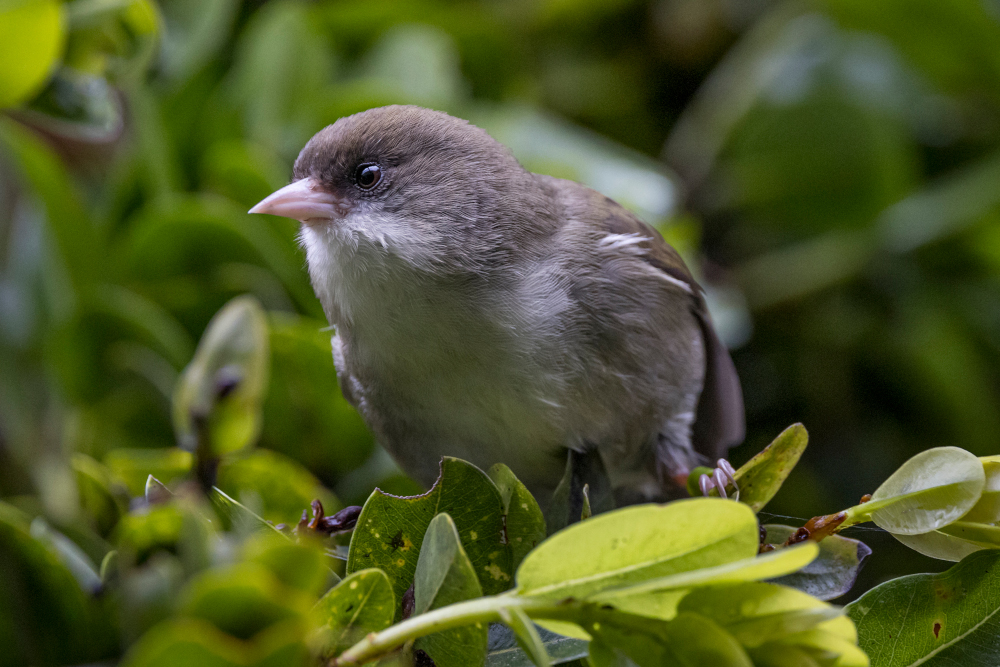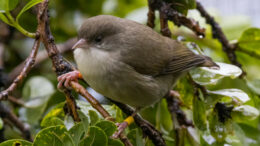The ʻakikiki is a critically endangered species of Hawaiian honeycreeper endemic to the island of Kauaʻi. Populations have shown rapid decline in the past five years. San Diego Zoo Wildlife Alliance operates a conservation-breeding program on the islands of Maui and Hawaiʻi in an effort to save the species. Researchers have studied mate choice selection as a means of increasing reproductive success and the number of individuals in the population.
Species name:
ʻAkikiki (Oreomystis bairdi)
Description:
A small (12-15 grams) creeper species. Light-cream to pale-gray underside with a dark-gray back. A small, pointed beak for gleaning insects from branches and leaves.

Where it’s found:
High-elevation forest in the Alakaʻi Swamp on Kauaʻi. The population is restricted to an area less than 7 square miles.
IUCN Red List status:
Critically endangered. The population faces rapid decline: Scientists estimate that only 40 birds remain in the wild.
Major threats:
Avian malaria and avian poxvirus have spread to the birds through mosquitos that were introduced to the islands. The birds evolved in isolation from these diseases and have no immunity. Climate change has exacerbated the problem, allowing the mosquitos to increase their range and reach the last strongholds in the cooler mountain forests.
Notable conservation programs or legal protections:
Federal listing under the Endangered Species Act in 2010. San Diego Zoo Wildlife Alliance works in conjunction with Kaua’i Forest Bird Recovery Project, State of Hawai‘i Department of Land and Natural Resources Division of Forestry and Wildlife, and others to protect the species. The first ‘akikiki eggs were brought into human care for conservation breeding in 2015 as a last-ditch effort.
My favorite experience:
I’ll never forget traveling to the remote regions of Kauaʻi and collecting ʻakikiki eggs from nests in conjunction with Kauaʻi Forest Bird Recovery Project. We set out in the hopes of establishing conservation-breeding flocks in case the species goes extinct in the wild. It was my first opportunity to see ʻakikiki in the wild, and the views from the helicopter were amazing. Being high up in the canopy collecting the tiny ʻakikiki eggs from nests was an adrenaline rush.
What else do we need to understand or do to protect this species?
Mate choice is an important component when managing species in a conservation-breeding program. Although genetic pairings are also critical to take into consideration, behavioral compatibility is important for picking pairs that will breed successfully. Like many species, when female ʻakikiki are allowed to have choice in selecting a preferred male, it increases overall reproductive success. My colleagues and I discovered this after conducting a study on the conservation-breeding flock of ʻakikiki over a span of three years.
Key research:
Alverson, D., Martin, M., Hebebrand, C.T., Greggor, A.L., Masuda, B., Swaisgood, R.R. (in review). Designing a mate choice program: tactics trialed and lessons learned with the critically endangered honeycreeper, ‘akikiki (Oreomystis bairdi). Conservation Science and Practice.
Paxton, E. H., Crampton, L. H., Vetter, J. P., Laut, M., Berry, L., & Morey, S. (2022). Minimizing extinction risk in the face of uncertainty: Developing conservation strategies for 2 rapidly declining forest bird species on Kaua‘i Island. Wildlife Society Bulletin 46.
Do you live in or near a threatened habitat or community, or have you worked to study or protect endangered wildlife? Share your stories in our ongoing features, Protect This Place and Species Spotlight.
![]()


